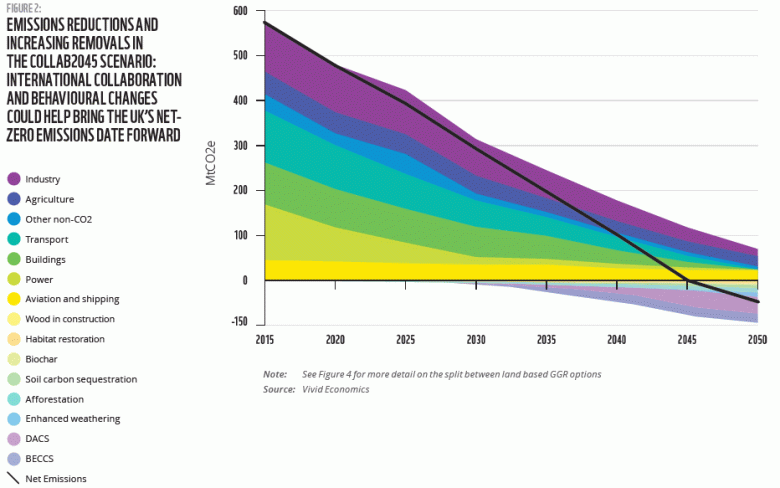Last week I wrote about how the British government was seeking advice on a zero carbon target, and the latest plan from Friends of the Earth. A similar report was released the same week by WWF, showing how the country could end its contribution to climate change by 2045.
Called Keeping it Cool, the report looks for opportunities to make deep emissions cuts, and then accelerates the shift to net zero by using techniques that store and reduce carbon. Put together, the path down the mountain looks something like this:

It’s good to see these land management and natural carbon capture techniques modeled. They feature so highly in the lists of most effective strategies (see Drawdown, for example) but rarely get mentioned. In WWF’s plan, we’d knock down emissions in industry, energy generation and buildings. Encouraging more sustainable diets gets a little further. ‘Hard to treat’ areas such as shipping and avaiation make a smaller contribution, but at least we can stop them growing.
Carbon negative strategies then remove an equivalent amount, helping us get to net zero. Reforestation is an obvious one, and better soil stewardship so that more carbon is stored in the soil. Those we know we can do. DACS, at the bottom there, is a bit harder. That’s ‘direct air capture’ with carbon storage – a proven technology, but not at scale and not within a business model that works just yet.
BECCS, just below it, is ‘bioenergy with carbon capture and storage’. That’s where you use biomass for energy – such as wood or agricultural waste burned in a power station – and then capture the carbon. The carbon absorbed as the plants grew is used or locked away, effectively making it a carbon negative form of energy.
If governments, businesses and citizens of developed countries had acted on climate change when it was first brought to our attention, we wouldn’t need these technologies to draw carbon out of the atmosphere. As it is, they’re going to have to be a part of the mix – not to offset emissions that we intend to ignore, but to accelerate the transition.

But won’t Beccs and soil carbon sequestration be trying to utilise the same resource?
There is some overlap – burning straw waste for energy would compete with leaving it on the fields as mulch. But there are soil conservation techniques that don’t involve waste, such as low-till agriculture. And there are BECCS sources that could be grown to order, leaving plenty left for composting.
They shouldn’t be mutually exclusive, but that’s a good question and they ought to be planned together to make sure that there is enough organic matter for soil restoration.